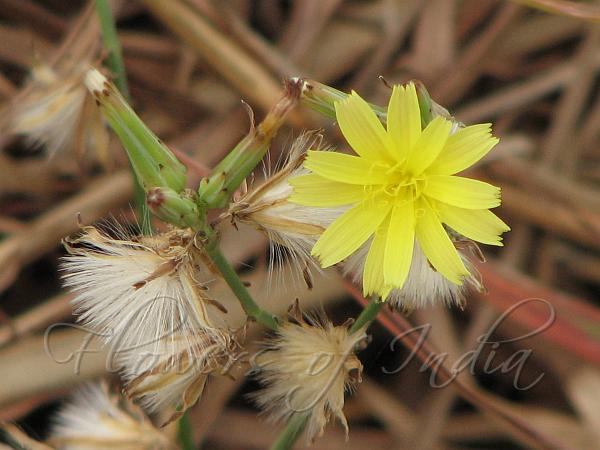|
| Rush Skeleton-Weed |
|

|

| File size | 1744844 |
| Original date | 3/15/09 10:29 AM |
| Resolution | 2816 x 2112 |
| Flash | Flash did not fire, auto, red-eye reduction |
| Focal length | 72.0mm |
| Exposure time | 1/400s |
| Aperture | 3.5 |
| Focus Distance | |
| Metering Mode | Multi-segment |
| Camera make | Canon |
| Camera model | Canon PowerShot S3 IS |
| Sensor type | OneChipColorArea |
|
|
|
|
Photo: |
Botanical name: Chondrilla juncea Family: Asteraceae (Sunflower family)
Rush Skeleton-Weed is a thin, spindly plant which reaches a meter in
height. It starts from a basal rosette of leaves and branches extensively,
often forming a weedy thicket. The plant is mostly 0.4-1.5 m tall,
appearing somewhat rush-like. The lowermost part of the branching stem
bears distinctive large, spreading to slightly descending, reddish hairs.
The upper stem is hairless. Cut surfaces of stems and leaves release milky
sap. The early-deciduous basal leaves are well-developed, pinnately cut,
5-13 cm long, 3.5 cm wide, and strongly resemble
dandelion leaves. The stem leaves are linear,
2-10 cm long and 1-8 mm wide, and often falling off. The upper leaves are
often reduced to scale-like bracts. The flower heads are scattered along
the branches, commonly with 9-12 yellow, strap-shaped "petals" (ray
florets) per head. The involucre of bracts is 9-12 mm high, and thinly
clothed with white, curly, hairs. The fruit is pale brown to almost black,
3-3.5 mm long, with five broadly rounded longitudinal ribs separated by
grooves. The tip of the fruit body bears small pointed bumps then 5 small
scales at the base of a long, slender beak, which bears the pappus of
hair-like bristles. It reproduces by seed but also by cloning itself at
the root; tilling of soil and chopping up plants actually help this
species disperse by sectioning and distributing root parts. This plant is
considered a very troublesome weed in many areas. Rush Skeleton-Weed is
native to the Mediterranean region of Europe, North Africa, and Asia Minor.
Found flowering: March.
Identification credit: Dimple Bhati
| Photographed in Kanha National Park, Madhya Pradesh. |